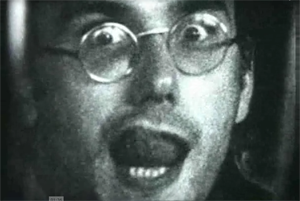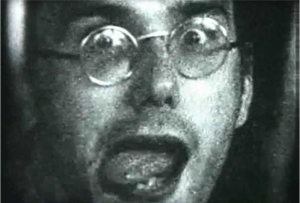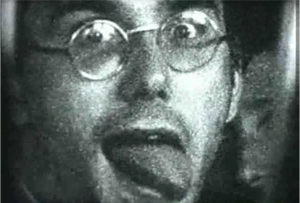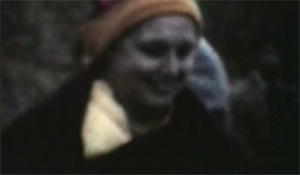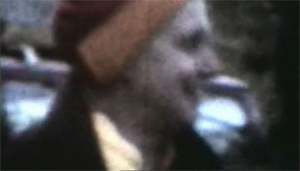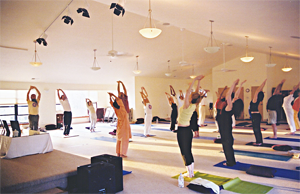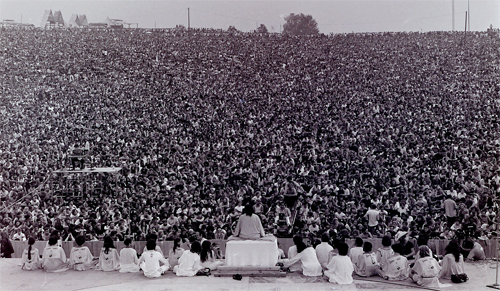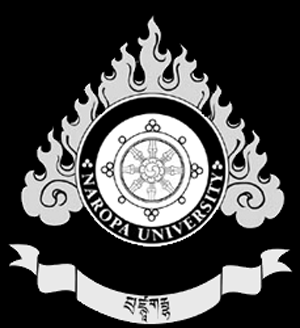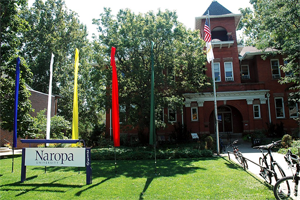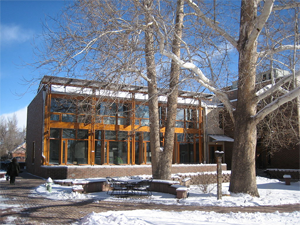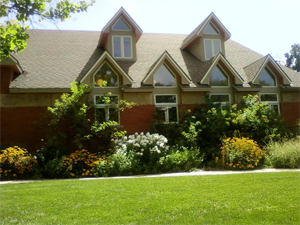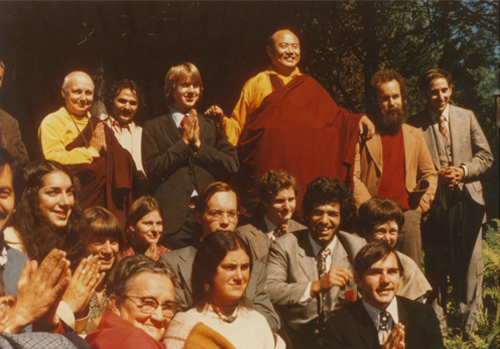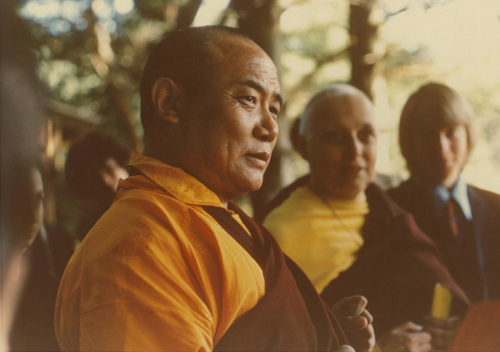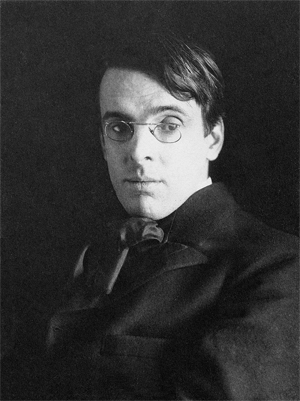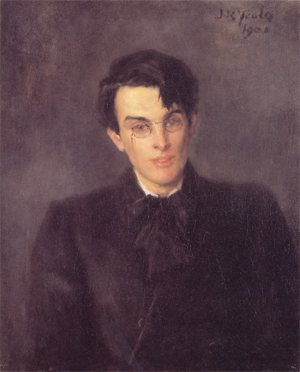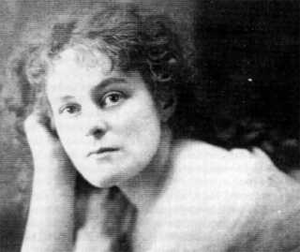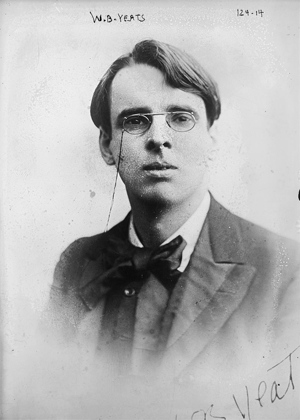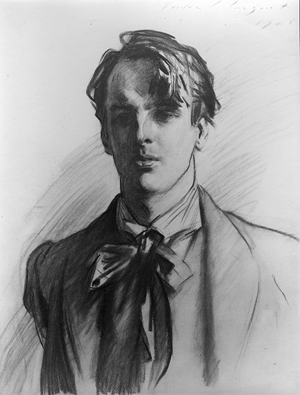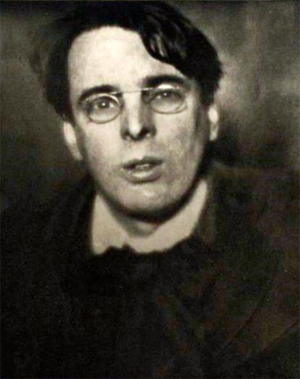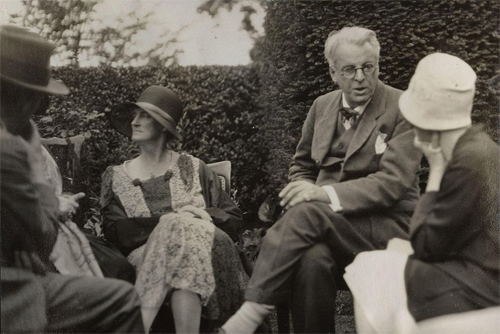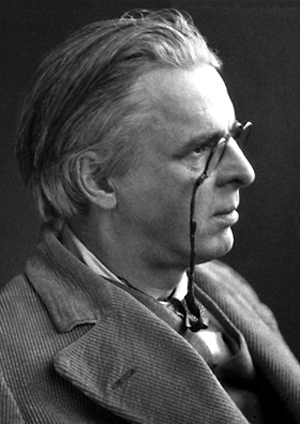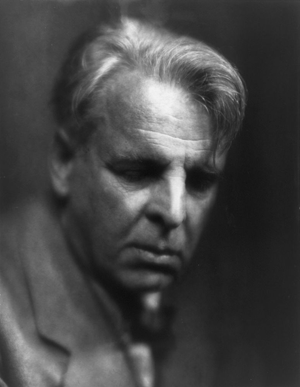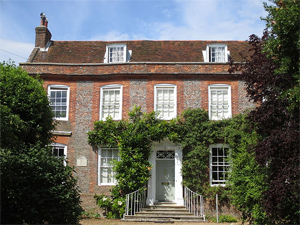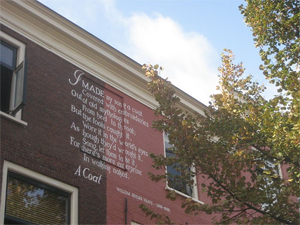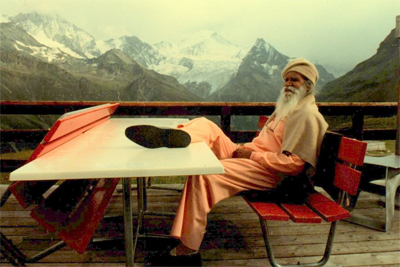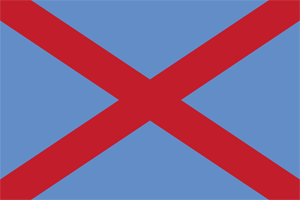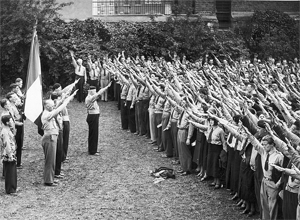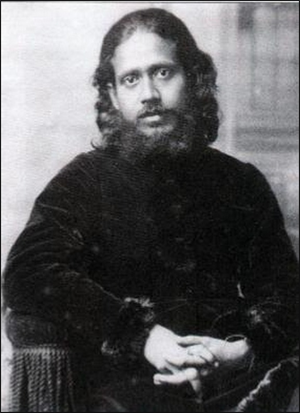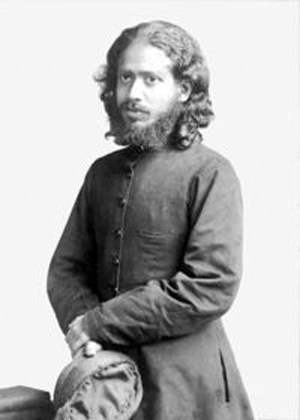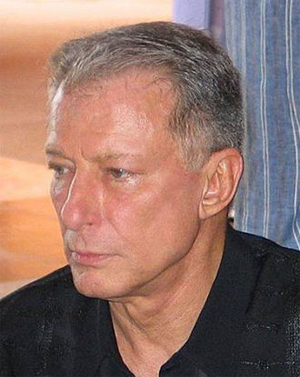Part 2 of 2
Barbados GroupThe Barbados Group represents a "self-selected group of scholars, consultants and practitioners"[171] which aims to build an ontological paradigm of performance in organizations.[172] The group and its main publication-vehicle SSRN both have at their head Michael C. Jensen, Emeritus Professor at the Harvard Business School. Werner Erhard's Barbados Group publications can be found at SSRN.[173] Some members of the Barbados Group are affiliated with Landmark Education.[174]
The Barbados Group was analyzed by economics journalist and author David Warsh, in an article in Economic Principals.[175]
Film and televisionSee also: est and The Forum in popular culture
In 2006 Erhard appeared in the documentary Transformation: The Life and Legacy of Werner Erhard.[176] Robyn Symon and Walter Maksym (who had earlier served as Erhard's attorney in the lawsuit against CBS) co-produced the film.[176]
Werner Erhard featured in the 2002 British documentary by Adam Curtis, The Century of the Self, episode part 3 of 4. This segment of the video discusses the est Training in detail, and includes interviews with est graduates John Denver and Jerry Rubin.
Publications
Selected Erhard writings as lead author• Being Well Chapter 5 in Beyond Health and Normality: Explorations of Exceptional Psychological Well-Being, edited by Roger Walsh, M.B., PhD and Deane H. Shapiro Jr., PhD. Van Nostrand. 1983.[177]
• A Breakthrough in Individual and Social Transformation in Eranos Foundation Yearbook 69: 2006/2007/2008. Daimon Verlag. 2010.[16]
• Creating Leaders: An Ontological/Phenomenological Model with Michael C. Jensen, and Kari Granger, Chapter 16 in Handbook For Teaching Leadership: Knowing, Doing, and Being, edited by Scott A. Snook, Rakesh Khurana, and Nitin Nohria, Harvard Business School. SAGE Publications. 2012.[178]
• Epistemological And Contextual Contributions of est to General Systems Theory – presentation to the symposium on Evolving Trends in General Systems Theory and the Future of the Family at the Sixth World Congress of Social Psychiatry, Opatija, Yugoslavia, 5 October 1976.[179]
• est: Communication in a Context of Compassion with Victor Gioscia, PhD. The Journal of Current Psychiatric Therapies, Volume 18. 1978.
• The est Standard Training with Victor Gioscia, PhD. Biosciences Communication 3:104-122. 1977.[180]
• Ethiopia: 1988 A Remarkable Achievement – newspaper article, 12 January 1989.[181]
• Four Ways of Being that Create the Foundations of A Great Personal Life, Great Leadership and A Great Organization with Michael C. Jensen, Jesse Isidor Straus Professor of Business Administration, Emeritus Harvard Business School.[182]
• Hayek: A Collaborative Biography: Part 1 Influences from Mises to Bartley, Chapter 12: "Bill Bartley: An Extraordinary Biographer" edited by Robert Leeson, Visiting Professor of Economics at Stanford University. Palgrave Macmillan. 2013.[46]
• The Hunger Project Source Document, The End of Starvation: Creating an Idea Whose Time Has Come 1977.[183]
• Integrity: A Positive Model that Incorporates the Normative Phenomena of Morality, Ethics and Legality with Michael C. Jensen, and Steve Zaffron. Harvard Business School NOM Working Paper No. 06-11; Barbados Group Working Paper No. 06-03; Simon School Working Paper No. FR 08-05.[184]
• Introductory Reading for the 'Being a Leader and The Effective Exercise of Leadership: An Ontological / Phenomenological Model' Course with Michael C. Jensen, and Steve Zaffron. Harvard Business School NOM Unit Working Paper No. 12-074; Barbados Group Working Paper No. 12-01; European Corporate Governance Institute (ECGI) – Finance Working Paper No. 417/2014.[185]
• The Mind's Dedication to Survival with Gilbert Guerin and Robert Shaw The Journal of Individual Psychology Volume 31, Number 1, May. 1975.[186]
• Putting Integrity Into Finance: A Purely Positive Approach with Michael C. Jensen. Journal: Capitalism and Society, Issue 12, Volume 1, May 2017;[38] National Bureau of Economic Research (NBER) #19986, March 2014;[5] European Corporate Governance Institute (ECGI) Finance Working Paper No. 417/2014;[39] and Harvard Law School Forum on Corporate Governance and Financial Regulation.[187]
• Some Aspects of the est Training and Transpersonal Psychology: A Conversation with James Fadiman. The Journal of Transpersonal Psychology, Volume 9, Number J. 1977.[188]
Published Interviews• You Don't Alter What You Know, You Alter The Way You Know It − An Interview with Werner Erhard. The Network Review, Volume 1, Number 4. 1983.[189]
• Werner Erhard on Transformation and Productivity – An Interview with Werner Erhard. Revision: The Journal of Consciousness and Change, Volume 7, Number 3. Winter 1984/Spring 1985.,
Books by others• Bartley, William Warren III: Werner Erhard The Transformation of a Man: The Founding of est, New York: Clarkson N. Potter Inc. (1978) ISBN 0-517-53502-5.
• Bry, Adelaide: est: 60 Hours That Transform Your life, Harper Collins (1976) ISBN 978-0-06-010562-4.
• Fenwick, Sheridan: Getting It: The psychology of est, J. B. Lippincott Company. (1976) ISBN 0-397-01170-9.
• Hargrove, Robert: est: Making Life Work, Delacorte (1976) ISBN 978-0-440-19556-6.
• Kettle, James: The est Experience, Zebra Books (1976) ISBN 978-0-89083-168-7.
• Marks, Pat R.: est: The Movement and the Man, Playboy Press (1976) ASIN B004BI5A3E.
• Morantz, Paul and Lancaster, Hal: Escape: My Life Long War Against Cults, Cresta Publications (2013) ISBN 978-0-615-84869-3.
• Moreno, M.D., Ph.D., Jonathan D. Impromptu Man: J.L. Moreno and the Origins of Psychodrama, Encounter Culture, and the Social Network. Bellevue Literary Press (2014) ISBN 1-934137-84-7.
• Pressman, Steven: Outrageous Betrayal: The Dark Journey of Werner Erhard from est to Exile, New York, New York, USA: St. Martin's Press (1993) ISBN 0-312-09296-2.
• Rhinehart, Luke: The Book of est, Holt, Rinehart and Winston (1976) ISBN 978-0-557-30615-2.
• Rubin, Jerry: Growing (Up) at Thirty-Seven, M. Evans & Company. (1976) ISBN 978-0-87131-189-4.
• Self, Jane: 60 Minutes and the Assassination of Werner Erhard: How America's Top Rated Television Show Was Used in an Attempt to Destroy a Man Who Was Making a Difference, Breakthru Publishing (1992) ISBN 0-942540-23-9.
• Weir, D., Noyes, D.: Raising Hell: How the Center for Investigative Reporting Gets the Story, chapter "Let Them Eat est". Addison-Wesley (1983) ISBN 0-201-10858-5.
See also• Large-group awareness training
Notes1. integrity,[4][5][6] leadership [7][8][9] personal and organizational performance, [10][11][12] and individual and organizational transformation.[13][14]
2. Some of the Universities Erhard has given talks or taught classes at are Harvard University,[15] Stanford University,[16] Dartmouth Geisel School of Medicine,[17] University of California, Berkeley,[18] University of Chicago,[18] University of Southern California,[19] University of Rochester,[20] Erasmus University Rotterdam,[21] Yale University,[22]Massachusetts Institute of Technology (MIT),[23] Oxford University, Oxford Union,[24] University of California, Los Angeles[25] and the US Air Force Academy.[26]
3. Talks: [34][35][36]
4. Erhard's writings appear: at Social Science Research Network,[37] in Columbia University's Capitalism and Society Center Journal, May 2017,[38] in the National Bureau of Economic Research (NBER),[5] at the European Corporate Governance Institute (ECGI) Working Paper Series in Finance (April 2014)[39] or linked from the Harvard Law SchoolForum on Corporate Governance and Financial Regulation (March 2014).[40]
5. [clarification needed]Philosophers Isaiah Berlin, Hubert Dreyfus,[48] Michel Foucault,[49] Karl Popper,[49] Hilary Putnam,[49] and Michael E. Zimmerman;[50][26] leadership and business academics Warren Bennis,[51][26] Fernando Flores,[52][53] Ronald Heifetz,[26] and Dave Logan;[50] economists Milton Friedman[54] and Michael C. Jensen;[50]neuroscientists David Eagleman and Karl H. Pribram; theoretical physicists Richard Feynman[49][55] and Leonard Susskind;[55] anthropologist Gregory Bateson;[56] cyberneticists Heinz von Foerster and James Grier Miller; biologist Humberto Maturana;[49][57] artist Robert Rauschenberg;[58] IBM fellow Allan Scherr;[50] and futurist R. Buckminster Fuller;[59]among others.[60] Philosopher Michael E. Zimmerman said of Erhard, "He had no particular formal training in anything, but he understood things as well as anyone I'd ever seen; and I've been around a lot of smart people in academia."[61]
References[edit]
1. Bartley, William Warren III(1978). Werner Erhard: The Transformation of a Man, the Founding of est. New York: Clarkson N. Potter. ISBN 0-517-53502-5.
2. Bartley, William Warren III (1978). Werner Erhard: The Transformation of a Man, the Founding of est. New York: Clarkson N. Potter. ISBN 0-517-53502-5. est is a training program in the expansion and transformation of consciousness which was founded by Werner Erhard in California in 1971.
3. Erhard, Werner. "Curriculum Vitae". Werner Erhard. Retrieved February 2, 2017. These companies were: Erhard Seminars Training Inc. (1971–1975); est, an educational corporation (1975–1981), and Werner Erhard and Associates (1981–1991).
4. Erhard, Werner; Jensen, Michael C.; Zaffron, Steve (February 2016). "Integrity: A Positive Model that Incorporates the Normative Phenomena of Morality, Ethics, and Legality". SSRN. We show that defining integrity as honoring one's word, as we have defined 'honoring one's word': 1) provides an unambiguous and actionable access to the opportunity for superior performance and competitive advantage at the individual, organizational and social levels, and 2) empowers the three virtue phenomena of morality, ethics and legality.
5. Erhard, Werner; Jensen, Michael C. (March 2014). "Putting Integrity into Finance: A Purely Positive Approach". NBER Working Paper No. 19986. doi:10.3386/w19986. We summarize here our new theory of integrity that reveals integrity as a purely positive phenomenon with no normative aspects whatsoever.
6. Madden, Bartley J. (August 28, 2012). "Management's Worldview: Four Critical Points about Reality, Language, and Knowledge Building to Improve Organization Performance". Journal of Organizational Computing and Electronic Commerce. 22(4): 334–346. doi:10.1080/10919392.2012.723586. Werner Erhard, Michael Jensen, and their Barbados Group colleagues (hereafter EJB) have developed a new paradigm of individual, group, and organizational performance. [...] A centerpiece of EJB's new paradigm is its emphasis on integrity (keeping one's word), which has significant impact on performance [...].
7. Erhard, Werner; Jensen, Michael C.; Granger, Kari (2012). Snook, Scott; Nohria, Nitin; Khurana), Rakesh (eds.). "Creating Leaders: An Ontological/Phenomenological Model", in The Handbook for Teaching Leadership: Knowing, Doing, and Being. SAGE Publications. pp. xxii–xxiv, 245–262. ISBN 978-1-4129-9094-3. Retrieved December 13, 2015.
8. Erhard, Werner; Jensen, Michael C.; Granger, Kari L. (2011). "Introduction to Being a Leader and the Effective Exercise of Leadership: An Ontological Model (PDF File of PowerPoint Slides)". doi:10.2139/ssrn.1392406. ISSN 1556-5068.
9. Erhard, Werner; Jensen, Michael C.; Zaffron, Steve; Granger, Kari L. (2011). "Course Materials for Being a Leader and the Effective Exercise of Leadership: An Ontological/Phenomenological Model". doi:10.2139/ssrn.1263835. ISSN 1556-5068.
10. Madden, Bartley J. (August 28, 2012). "Management's Worldview: Four Critical Points about Reality, Language, and Knowledge Building to Improve Organization Performance". Journal of Organizational Computing and Electronic Commerce. 22 (4): 334–346. doi:10.1080/10919392.2012.723586. Werner Erhard, Michael Jensen, and their Barbados Group colleagues (hereafter EJB) have developed a new paradigm of individual, group, and organizational performance
11. Zaffron, Steve; Logan, David (2009). The Three Laws of Performance: Rewriting the Future of Your Organization and Your Life. Jossey-Bass. ISBN 978-0-470-19559-8. This section draws on work from Werner Erhard, Michael C. Jensen, and Steve Zaffron, 'Integrity: A Positive Model That Incorporates the Normative Phenomena of Morality, Ethics and Legality,', Harvard Business School NOM Working Paper no. 06-11 (April 25, 2008). Available at
http://ssrn.com/abstract=92062512. "John F Kennedy School Center for Public Leadership Harvard University". YouTube. March 6, 2008. Retrieved November 13, 2011.
13. "Werner Erhard on Transformation and Productivity: An Interview with Werner Erhard", by Norman Bodek, ReVision: The Journal of Consciousness and Change, Vol 7, No. 2, Winter 1984 / Spring 1985
14. Erhard, Werner. "Archive of Articles". WernerErhard.net. Retrieved August 3,2015.
15. Jackson, Robert (November 9, 2007). "Michael Jensen's and Werner Erhard's Talk on Integrity – Harvard University Law School, November 9, 2007". Blogs.law.harvard.edu. Retrieved November 13, 2011.
16. Erhard, Werner (2010). "A Breakthrough in Individual and Social Transformation". In van Praag, John; Riccardo, Bernardini (eds.). Eranos Foundation Yearbook 69: 2006/2007/2008. Daimon Verlag. pp. 98–108. ISBN 978-3-85630-734-9.
17. "Dean's Leadership Course Attracts 165 Participants from Five Continents". Geisel School of Medicine. June 20, 2012. Retrieved December 13, 2015. Renowned leadership experts Dr. Chip Souba; Werner Erhard, researcher, lecturer and author; Michael C. Jensen, the Jesse Isidor Straus Professor of Business Administration, Emeritus, Harvard Business School; Steve Zaffron, CEO of Vanto Group; and Kari Granger; senior faculty member at the Sunergos Institute, are teaching the course over eight days at the Dartmouth campus.
18. Erhard, Werner; Jensen, Michael C. (2015). "Creating Leaders, a New Model: An Evening with Werner Erhard and Michael Jensen (PDF File of Powerpoint Slides)". doi:10.2139/ssrn.2606342. ISSN 1556-5068.
19. "USC.edu". Marshall.usc.edu. August 31, 2011. Archived from the original on November 26, 2010. Retrieved November 13, 2011. The Marshall School was pleased to host Harvard University Jesse Isidor Straus Professor of Business Administration, Emeritus, Michael C. Jensen, Werner Erhard, creator of transformational models and applications for individuals, groups, and organizations, and Steve Zaffron, CEO Landmark Education and Business Development, as our honored guests in the Marshall Distinguished Researcher Series for this past fall.
20. "Rochester.edu". Simon.rochester.edu. July 3, 2008. Retrieved November 13,2011. The course is co-taught with Alan Scherr, a consultant based in Rhinebeck, N.Y., Steve Zaffron of the Vanto Group and Werner Erhard, the creator of innovative ideas and models of individual, organizational and social transformation and recipient of the 1988 Mahatma Gandhi Humanitarian Award.
21. "HBS Professor Michael Jensen to Present Seminar at Erasmus Academie - About RSM - Rotterdam School of Management, Erasmus University". Rsm.nl. Archived from the original on April 19, 2012. Retrieved April 24, 2014. The seminar, 'Being a Leader and The Effective Exercise of Leadership: An Ontological Model,' will be led by Dr. Jensen, an internationally renowned business scholar, along with his team of fellow experts: Werner Erhard, Steve Zaffron and Kari Granger.
22. Erhard, Werner; Jensen, Michael C.; Zaffron, Steve (2009). "A New Model of Integrity: An Actionable Pathway to Trust, Productivity and Value (PDF File of Keynote Slides)". doi:10.2139/ssrn.932255. ISSN 1556-5068.
23. Goss, Tracy; Pascale, Richard T.; Athos, Anthony (November 1993). "The Reinvention Roller Coaster: Risking the Present for a Powerful Future". Harvard Business Review. "Transformation and Its Implications for Systems-Oriented Research," lecture at Massachusetts Institute of Technology, Cambridge, Massachusetts, April 1977. Retrieved December 13, 2015. [...] Werner Erhard, “Transformation and Its Implications for Systems-Oriented Research,” unpublished lecture, Massachusetts Institute of Technology, Cambridge, Massachusetts, April 1977 [...].
24. "The Nature of Transformation," Oxford University Union Society, Oxford, England, September 1981
25. Goulston, Mark (November 2009). "2009 Neuroleadership Summit - How to foil an amygdala hijack". Psychology Today.
26. Snook, Scott; Khurana, Rakesh; Nohria, Nitin (September 21, 2011). The Handbook for Teaching Leadership: Knowing, Doing, and Being. Sage Publications. p. 259. ISBN 978-1412990943.
27. BEN., AMOR (2017). URBAN SHEPHERD : chasing the American Dream. [S.l.]: DOG EAR PUBLISHING. ISBN 978-1457545344. OCLC 985912622.
28. "The Hunger Project". CSO-Net. Economic and Social Council. Retrieved 30 Nov. 2015.
29. Encyclopedia of human rights. Lawson, Edward (Edward H.), Bertucci, Mary Lou. (2nd ed.). Washington, DC: Taylor & Francis. 1996. ISBN 1560323620. OCLC 34731141.
30. Ben, Amor (2017). Urban Shepard : Chasing the American Dream. [S.l.]: DOG EAR PUBLISHING. ISBN 978-1457545344. OCLC 985912622.
31. "Werner Erhard - The Hunger Project Source Document".
www.wernererhard.net. Retrieved May 18, 2018.
32. Symon, Robyn. "Transformation: The Life & Legacy of Werner Erhard: 2005". Symon Productions, Inc. and Eagle Island Films.
33. U.S.A. "The Believer - est, Werner Erhard, and the Corporatization of Self-Help". Believermag.com. Retrieved December 16, 2013.
34. Erhard, Werner; Jensen, Michael C.; Zaffron, Steve; Scherr, Alan (July 3, 2008). "Leadership Seminar Series: The Ontological Foundations of Leadership and Performance". Simon Business School. University of Rochester. Retrieved January 28, 2017. The course is co-taught with Alan Scherr, a consultant based in Rhinebeck, N.Y., Steve Zaffron of the Vanto Group and Werner Erhard, the creator of innovative ideas and models of individual, organizational and social transformation and recipient of the 1988 Mahatma Gandhi Humanitarian Award.
35. Erhard, Werner; Jensen, Michael C. (November 9, 2009). "Michael Jensen's and Werner Erhard's Talk on Integrity – Harvard University Law School". Harvard Law School Forum on Corporate Governance and Financial Regulation. Harvard University Law School. Retrieved December 13, 2015.
36. Erhard, Werner (December 14, 2009). "John F Kennedy School Center for Public Leadership Harvard University". YouTube. Retrieved December 13, 2015.
37. Erhard, Werner. "Scholarly Papers". Social Science Research Network. Retrieved July 21, 2015.
38. Erhard, Werner; Jensen, Michael C. (May 2017). "Putting Integrity Into Finance: A Purely Positive Approach". Journal: Capitalism and Society. Columbia University. 1 (12).
39. Erhard, Werner; Jensen, Michael C. "Putting Integrity into Finance: A Purely Positive Approach". European Corporate Governance Institute.
40. Erhard, Werner; Jensen, Michael C. "Putting Integrity into Finance: A Purely Positive Approach". Harvard Law School Forum on Corporate Governance and Financial Regulation.
41. Steven M. Tipton, Getting Saved from the Sixties: Moral Meaning in Conversion and Cultural Change. Berkeley: University of California Press, 1982, p. 176.
42. Wakefield, Dan. "Erhard's Life After est Common boundary: March/April 1994". wernererhard.com. Archived from the original on May 12, 2010.
43. Iaccoca, Lee (1984). Iacocca: An autobiography. New York: Bantam Books. ISBN 0-553-38497-X
44. Johns, John (May 1976). "Interview with Werner Erhard". PSA Magazine.
45. The Graphic Designer's Guide to Clients, by Ellen M. Shapiro
46. Erhard, Werner (2013). "Bill Bartley: An Extraordinary Biographer". In Leeson, Robert (ed.). Hayek: A Collaborative Biography: Part 1 Influences from Mises to Bartley. Archival Insights into the Evolution of Economics. Springer. pp. 234–236. ISBN 9781137328564. Retrieved May 28, 2019.
47. "Lunch with the FT: Werner Erhard". The Financial Times. April 28, 2012.
48. Young, Julian (May 16, 2014). The Death of God and the Meaning of Life. Routledge. ISBN 9780415841139.
49. Smith, David L. (2013). The Predicament: How Did It Happen? How Bad Is It? The Case For Radical Change Now. Sic Itur Ad Astra Publishers. ISBN 978-0988872806.
50. Zaffron, Steve; Logan, Dave (August 30, 2011). The Three Laws of Performance. Jossey-Bass. ISBN 978-1118043127.
51. Bennis, Warren; Biederman, Patricia Ward, Contributor (August 16, 2010). Still Surprised: A Memoir of a Life in Leadership. John Wiley & Sons. ISBN 978-0-470-94464-6.
52. Swahn, Anders Lennart and Staffan (September 15, 2008). Creativity: A Science-based Outlook on Life and Work. AuthorHouse. pp. XV. ISBN 9781434381828.
53. Wildflower, Leni (February 1, 2013). The Hidden History Of Coaching. Open University Press. ISBN 978-0-33-524540-6.
54. Leeson, Editor, Robert (2013). Hayek: A Collaborative Biography: Part 1 Influences from Mises to Bartley. Palgrave Macmillan. ISBN 9780230301122.
55. Susskind, Leonard (July 8, 2014). Brockman, John (ed.). The Universe: Leading Scientists Explore the Origin, Mysteries, and Future of the Cosmos. Harper Perennial. p. 169. ISBN 978-0062296085.
56. Harries-Jones, Peter (1995). A Recursive Vision: Ecological Understanding and Gregory Bateson. University of Toronto Press. ISBN 0-8020-7591-6.
57. Maturana, Humberto (2004). From Being to Doing: The Origins of the Biology of Cognition. Karnac Books. ISBN 9783896704481.
58. Rauschenberg, Robert; Erhard, Werner. "Communication and Finding Your Voice in Art". WernerErhardVideo.com. Retrieved April 16, 2017.
59. Zung, Thomas T. K. (January 20, 2001). Buckminster Fuller: Anthology for the New Millennium. St. Martin's Press. ISBN 0312266391.
60. Erhard, Werner (November 21, 2011). "Werner Erhard Curriculum Vitae at Social Science Research network". SSRN 1654395.
61. Symon, Robyn. "Transformation: The Life & Legacy of Werner Erhard: 2005". Symon Productions, Inc. and Eagle Island Films.
62. Kay Holzinger (February 1, 2001). "Erhard Seminars Training (est) and The Forum". In James R. Lewis (ed.). Odd gods: new religions & the cult controversy. Prometheus Books. ISBN 978-1-57392-842-7. Retrieved November 18, 2010.
63. Rawlinson, Andrew (December 31, 1998). The Book of Enlightened Masters: Western Teachers in Eastern Traditions. Open Court. p. : 261. ISBN 978-0812693102.
64. Rhinehart, Luke (1976). The Book of est. Holt, Rinehart and Winston.
65. name="Steven M. Tipton 1982, page 176"
66. Erhard, Werner; Gloscia, Victor (1977). "The est Standard Training". Biosciences Communication. 3: 104–122.
67. Kettle, James (1976). The est Experience. New York: Kensington Publishing Corporation. pp. 51, 52. ISBN 978-0890831687.
68. U.S.A. "The Believer - est, Werner Erhard, and the Corporatization of Self-Help". Believermag.com. Retrieved December 9, 2013.
69. Moreno, Jonathan D (2004). Impromptu Man: J.L. Moreno and the Origins of Psychodrama, Encounter Culture, and the Social Network. New York: Bellevue Literary Press. p. 246. ISBN 1934137847.
70. Hargrove, Robert (1976). est: Making Life Work. New York: Dell Books. p. 127. ISBN 978-0440195566.
71. "hotel to hospital – farewell to S.F. era". San Francisco Chronicle. October 31, 2009.
72. "Werner Erhard Foundation". Werner Erhard Foundation. Retrieved November 13, 2011.
73. "Werner Erhard Foundation".
74. Susskind, Leonard (2009). The Black Hole War: My Battle with Stephen Hawking to Make the World Safe for Quantum Mechanics. Back Bay Books. p. 191. ISBN 978-0-316-01641-4.
75. "Werner Erhard (est) Foundation Sponsored Experimental Physics Conference 1977: Novel Configurations In Quantum Field Theory".
76. Susskind, Leonard (2014). "The Landscape". In Brockman, John (Ed.) The Universe: Leading Scientists Explore the Origin, Mysteries, and Future of the Cosmos. New York: Harper Perennial. p. 169. ISBN 978-0-06-229608-5.
77. "Werner Erhard Video — Ideas In Conversation". Wernererhardvideo.com. July 11, 1987. Retrieved December 9, 2013.
78. Hayek: A Collaborative Biography, edited by Robert Lesson
79. "Werner Erhard: Biography, Writings, Interviews, Documents & Quotes". Wernererhardbiography.com. Retrieved December 9, 2013.
80. Sourcebook of Coaching History, Vikki G Brock PhD., 2012
81. "Landmark Education Corporation: Selling a Paradigm Shift", Harvard Business School Publishing, Boston, MA, Karen Hopper and Mikelle Fisher Eastley, 9-898-081, p.1, Rev. April 22, 1998. Availability restricted by Harvard "to faculty and staff of universities" (see Alex Beam, "Church takes to bully pulpit" in the Boston Globe, April 2, 1999, page F01; transcribed at Freedomofmind.com, retrieved October 21, 2007)
82. Compare Bärbel Schwertfeger, "Foreword" in Martin Lell, Das Forum: Protokoll einer Gehirnwäsche: Der Psycho-Konzern Landmark Education [The Forum: Account of a Brainwashing: The Psycho-Outfit Landmark Education], Deutscher Taschenbuch Verlag, Munich, 1997, ISBN 3-423-36021-6, page 8 : "Am 31.1.91 verkaufte Erhard seine Anteile für drei Millionen Dollar an seine Mitarbeiter, die die Organisation in Landmark Education umbenannten. Landmark verpflichtete sich zudem, in den folgenden achtzehn Jahren bis zu fünfzehn Millionen Dollar Lizenzgebühren an Erhard zu zahlen."
83. "Werner Erhard Curriculum Vitae". Wernererhard.net. Retrieved April 24, 2014.
84. Harvard Business Review On Change, Harvard Business Review Paperback Series, Harvard Business Press; 6 edition (September 1, 1998)
85. "Transformation and Its Implications for Systems-Oriented Research," lecture, Massachusetts Institute of Technology, Cambridge Massachusetts, April 1977
86. "Organizational Vision and Vitality: Forward from the Future," Academy of Management, San Francisco, California, August 1990
87. Hayek: A Collaborative Biography: Part 1 Influences from Mises to Bartley (Archival Insights Into the Evolution of Economics) by Robert Leeson, Editor, Palgrave Macmillan, 2013
88. Hilton, Ronald (1986). "World Affairs Report". California Institute of International Studies. 16-17.
89. Pay Money, Be Happy, New York Magazine, Vanessa Grigoriadis, July 9, 2001.
90. "Mastery Foundation". Mastery Foundation. Retrieved November 13, 2011.
91. Harvard CPL. "Harvard.Edu". Content.ksg.harvard.edu. Archived from the original on June 11, 2010. Retrieved November 13, 2011.
92. "MIT.edu". Mitsloan.mit.edu. Archived from the original on November 11, 2011. Retrieved November 13, 2011.
93. "Harvard.edu". Law.harvard.edu. Archived from the original on August 1, 2010. Retrieved November 13, 2011.
94. "Depaul.edu". Fac.comtech.depaul.edu. May 8, 2008. Retrieved November 13,2011.
95. "Simon Business School". rochester.edu. Archived from the original on October 11, 2008.
96. The Oxford Handbook of Organizational Well-Being, by Susan Cartwright and Cary L. Cooper
97. "Werner Erhard speaks to Kennedy School students". YouTube. December 14, 2009. Retrieved December 9, 2013.
98. Jensen, Michael C. (Fall 2009). "Integrity: Without it Nothing Works". Rotman Magazine. pp. 16–20. SSRN 1511274.
99. Oran, Suzan; Conard, Scott (November 2014). The Art of Medical Leadership: Expand Your Influence. Wheatmark Inc. ISBN 978-1627871778.
100. Kellaway, Lucy; Hill, Andrew (April 27, 2012). "Lunch with The FT: Werner Erhard". Financial Times.
101. Madden, Bartley J. (September 30, 2014). Reconstructing Your Worldview. Learning What Works.
102. Starr, Gordon (July 21, 2015). "Global Leadership Is Desperately Missing. It's Costing Us Our Future. Can we transform our crisis of leadership?". The Huffington Post.
103. "Nitin Nohria - Faculty - Harvard Business School". Drfd.hbs.edu. Retrieved December 9, 2013.
104. "Rakesh Khurana - Faculty - Harvard Business School". Drfd.hbs.edu. Retrieved December 9, 2013.
105. The Handbook for Teaching Leadership: Knowing, Doing, and Being, edited by Snook, Scott A., Nohria, Nitin N., and Khurana, Rakesh, Sage Publications, Inc., 2011.
106. "Program Information". Natcom.org. Archived from the original on May 19, 2014. Retrieved April 24, 2014.
107. "Hayek: A Collaborative Biography". palgrave.com.
108. "ECGI New Finance Working Paper alert - Putting Integrity into Finance: A Purely Positive Approach". ecgi.org.
109. Marc Galanter: Cults: faith, healing, and coercion. New York/Oxford: Oxford University Press, 1989. ISBN 978-0-19-505631-0, page 80.
110. Zimmerman, Michael E. "est: A Philosophical Appraisal".
111. Transformation: The Life and Legacy of Werner Erhard on IMDb
112. "Documentary, 2006, Directed by Robyn Symon". Transformationfilm.com. Retrieved April 24, 2014.
113. Carroll, Roberta (2004). The Skeptic's Dictionary: A Collection of Strange Beliefs, Amusing Deceptions, and Dangerous Delusions. John Wiley&Sons. p. 126. ISBN 978-0-471-48088-4.
114. MacCleary, John Bassett. (2004), The Hippie Dictionary: A Cultural Encyclopedia of the 1960s and 1970s, Page 165., Ten Speed Press, ISBN 1-58008-547-4
115. Vitz, Paul C. (1994). Psychology As Religion: The Cult of Self-Worship. Wm. B. Eerdmans Publishing Company. p. 26. ISBN 0-8028-0725-9.
116. Faltermayer, Charlotte (June 24, 2001). "The Best Of Est?". Time. Retrieved September 28, 2007.
117. Charlotte Faltermayer. "The Best of est?". Time. Retrieved November 3, 2012.
118. San Jose Mercury News staff (April 7, 1992). "Est Founder sues critics: suit names Mercury News writer". San Jose Mercury News. p. 8B.
119. United Press International staff (March 4, 1992). "EST guru sues CBS, Enquirer, Hustler". United Press International. p. Domestic News.
120. Werner Erhard vs. Columbia Broadcasting System, (Filed: March 3, 1992) Case Number: 1992-L-002687. Division: Law Division. District: First Municipal. Cook County Circuit Court, Chicago, Illinois.
121. Steve Jackson. "It Happens – Page 8 – News – Denver". Westword. Retrieved November 13, 2011.
122. Grigoriadis, Vanessa (July 9, 2001). "Pay Money, Be Happy". New York Magazine. New York Media Holdings. Retrieved November 12, 2010.
123. Charlotte Faltermayer (June 24, 2001). "The Best Of est". Time.
124. Fischer, Jack (August 14, 1993). "$2 million suit against MN dismissed – No harm to Erhard's daughter seen". San Jose Mercury News. California. p. 6B.
125. "Daughter of est founder sues Mercury News over two articles", San Jose Mercury News, July 16, 1992
126. "Suit against MN ends in paper's favor". San Jose Mercury News. January 14, 1994. p. 2B.
127. Jardin, Xeni (August 31, 2009). "Wikileaks re-publishes 60 Minutes piece on est/Landmark cult leader Werner Erhard". Boing Boing. boingboing.net. Retrieved October 27, 2010.
128. Pressman, Steven (1993). Outrageous Betrayal. St Martin's Press. ISBN 0-312-09296-2.
129. Wikisource:Ney v. Landmark Education Corporation and Werner Erhard
130. "Leader of est movement wins $200,000 from IRS". Daily News of Los Angeles. Los Angeles, California. September 12, 1996.
131. "IRS starts liening on Werner Erhard". Chicago Sun-Times. Chicago, Illinois. April 15, 1991.
132. "IRS Settles Lawsuit brought by Werner Erhard," Business Wire, September 11, 1996.
133. Welkos, Robert W. (December 29, 1991). "Founder of est Targeted in Campaign by Scientologists : Religion: Competition for customers is said to be the motive behind effort to discredit Werner Erhard". Los Angeles Times.
134. Melton, J. Gordon; James R. Lewis (1992). Perspectives on the New Age. SUNY Press. pp. 129–132. ISBN 0-7914-1213-X.
135. "Distilled Wisdom: Buddy, Can you Paradigm", Fortune Magazine, May 15, 1995.
136. Peter Block: Community, the Structure of Belonging, Berrett-Koehler, 2008, pg.14
137. Bruce Schulman: The Seventies: The Great Shift in American Culture, Society, and Politics, Da Capo Press, April 16, 2002, pages 96–98
138. Jane Renton, "Coaching and Mentoring: What They Are and How to Make the Most of Them", The Economist Newspaper, Ltd.,2009, pgs 8 & 27
139. About CTI, History, The Coaches Training Institute.
140. Babbie, Earl (1977). Society by Agreement. Wadworth Publishing Company, Inc.
141. Nike vs. Reebok a battle for hearts, minds & feet, Fortune Magazine, by Kenneth Labich & Tim Carvell, September 18, 1995
142. Peter Block: Community, the Structure of Belonging, Berrett-Koehler, 2008, p. 14
143. Warren Bennis: Leaders: Strategies for Taking Charge, Harper Collins, 2003, pg 201
144. "Morgan Stanley and AFA Announce Michael C. Jensen as Recipient of the 2009 Award for Excellence in Financial Economics". morganstanley.com.
145. Peter Block: Community, the Structure of Belonging, Berrett-Koehler, 2008, pg.198
146. "Transformationfilm.com". Transformationfilm.com. Retrieved October 6, 2015.
147. "Transformationfilm.com". Transformationfilm.com. Retrieved November 13,2011.
148. Marianne Williamson, The Age of Miracles: Embracing the New Midlife;Hay House Inc., January 31, 2008, pgs x, xi
149. Casey Hawley:100+ Tactics for Office Politics (Barron's Business Success Guides); Barrons Educational Series; 2 edition, June 1, 2008, page 173
150. Wakefield, Dan (1994). "Review of Outrageous Betrayal: The Dark Journey of Werner Erhard from est to Exile: by Steve Pressman". Tricycle: The Buddhist Review.
151. Hayes, PhD, Steven C. Steven C. Hayes, PhD - Career Influences and a Brief Intellectual Autobiography.
152. Madden, Bartley J. (2014). Reconstructing Your Worldview: The Four Core Beliefs You Need to Solve Complex Business Problems. Naperville: Learning What Works. p. 99. ISBN 978-0-9885969-2-4.
153. Greenberg, Marvin Jay. 2008. Euclidean and Non-Euclidean Geometries: Development and History. New York, NY: W. H. Freeman and Company
154. Roth, Bernard (2015). The Achievement Habit: Stop Wishing, Start Doing, and Take Command of Your Life. New York: Harper Business. pp. 205–206. ISBN 978-0-06-235610-9.
155. Roth, Bernard (2015). The Achievement Habit: Stop Wishing, Start Doing, and Take Command of Your Life. p. 261. ISBN 978-0-06-235610-9.
156. The End of Starvation: Creating an Idea Whose Time Has Come, Werner Erhard, 1977
157. Erhard, Werner (1977). The End of Starvation: Creating an Idea Whose Time Has Come.
158. Interview with Catherine Parrish, former CEO of the Hunger Project
http://wernererhardvideo.com/catherine- ... er-erhard/159. Pennington, Basil O.C.S.O., Monk of Cistercian Order, Roman Catholic Church (December 1989). "The Forum: Basic Course in Living Reality". The Priest.
160. Twist, Lynne (2003). The Soul of Money: Transforming Your Relationship with Money and Life. W.W. Norton& Co.
161. Pallotta, Dan (September 4, 2012). Charity Case: How the Nonprofit Community Can Stand Up For Itself and Really Change The World. Jossey-Bass.
162. Gordon, Suzanne (December 1978). "Let Them Eat est" (PDF). Mother Jones Magazine. Retrieved July 11, 2016.
163. Gordon, Suzanne (December 1978). "Let Them Eat est" (PDF). Mother Jones Magazine. Retrieved July 11, 2016.
164. Gordon, Suzanne (August 2009). "The Hunger Artist: Let Them Eat est". Mother Jones Magazine. Retrieved July 12, 2016.
165. Parco, James E. (February 2010). Attitudes Aren't Free: Thinking Deeply About Diversity in the U.S. Armed Forces. Air University Press.
166. Faltermayer, Charlotte (June 24, 2001). "The Best Of Est?". TIME.
167. "Landmark Education, media Q&A". Landmarkeducation.com. Archived from the original on September 27, 2007. Retrieved November 13, 2011.
168. Appendix A. Text of Court Ruling in Ney Case – Source: LEXIS-NEXIS – STEPHANIE NEY, Plaintiff-Appellant, v. LANDMARK EDUCATION CORPORATION; RON ZELLER, Defendants-Appellees, and WERNER ERHARD; WERNER ERHARD AND ASSOCIATES; PETER SIAS, Defendants. – No. 92-1979 – UNITED STATES COURT OF APPEALS FOR THE FOURTH CIRCUIT – 1994 U.S. App. LEXIS 2373
169. Declaration filed May 5, 2005 at the US District Court of New Jersey, civil action 04-3022 (JCL), pp 3 and 4
170. "Landmark Education website". February 10, 2002. Archived from the originalon February 10, 2002. Retrieved November 13, 2011.
171. "Announcing Barbados Group Abstracting Journal". Archived from the originalon September 12, 2012. Retrieved December 16, 2013.
172. "Barbados Group for Development of a New Paradigm for Performance Research Paper Series". Retrieved December 16, 2013.
173. "Werner Erhard's Scholarly Papers". Retrieved November 13, 2011.
174. "SSRN". Retrieved November 13, 2011.
175. Warsh, David (April 8, 2007). "Beyond Coordination and Control Is... Transformation". Economic Principals.
176. :a b Guzman, Rafer (August 14, 2008). "Movie Buzz: Who Werner Erhard, The Deal The founder of the controversial training program called est". Newsday. Newsday, Inc. p. B9.
177. Erhard, Werner; Gioscia, Victor; Anbender, Ken (1983). "Being Well". In Walsh, Roger; Shapiro, Deane H. (eds.). Beyond Health and Normality: Explorations of Exceptional Pcychological Well-Being. Van Nostrand. ISBN 978-0-442-29173-0.
178. Erhard, Werner; Jensen, Michael C.; Granger, Kari (2012). Creating Leaders: An Ontological/Phenomenological Model, Chapter 16, in The Handbook for Teaching Leadership: Knowing, Doing, and Being (Eds. Scott A. Snook, Rakesh Khurana, and Nitin Nohria). SAGE Publications, Inc. pp. xxii–xxiv, 245–262. ISBN 978-1-4129-9094-3. Retrieved December 7, 2015.
179. Erhard, Werner; Gioscia, Victor. "Epistemological And Contextual Contributions of est to General Systems Theory". WernerErhard.net. Retrieved December 7, 2015.
180. Erhard, Werner; Gioscia, Victor (1977). "The est Standard Training". Biosciences Communication. 3: 104–122.
181. Erhard, Werner (January 12, 1989). "Ethiopia: 1988 A Remarkable Achievement". The Union Leader New Hampshire's Daily Newspaper. Manchester, N.H.
182. Erhard, Werner; Jensen, Michael C. (2013). "Four Ways of Being that Create the Foundations of A Great Personal Life, Great Leadership and A Great Organization". doi:10.2139/ssrn.2207782. ISSN 1556-5068.
183. Erhard, Werner (1977). "The End of Starvation: Creating An Idea Whose Time Has Come". Graduate Review Publication of the Hunger Project. Retrieved December 7, 2015.
184. Erhard, Werner; Jensen, Michael C.; Zaffron, Steve (2009). "Integrity: A Positive Model that Incorporates the Normative Phenomena of Morality, Ethics and Legality". doi:10.2139/ssrn.920625. ISSN 1556-5068.
185. Erhard, Werner; Jensen, Michael C.; Zaffron, Steve; Granger, Kari L. (2012). "Introductory Reading for Being a Leader and the Effective Exercise of Leadership: An Ontological/Phenomenological Model". doi:10.2139/ssrn.1585976. ISSN 1556-5068.
186. Erhard, Werner; Guerin, Gilbert; Shaw, Robert (May 1975). "The Mind's Dedication to Survival". The Journal of Individual Psychology. 31 (1).
187. Erhard, Werner; Jensen, Michael C. "Putting Integrity Into Finance". Harvard Law School Forum on Corporate Governance.
188. Erhard, Werner; Fadiman, James (1977). "Some Aspects of the est Training and Transpersonal Psychology: A Conversation". The Journal of Transpersonal Psychology. 9 (J): 27–42.
189. Erhard, Werner (1983). "You Don't Alter What You Know, You Alter The Way You Know It". The Network Review. 1 (4).
External links• Official website
• Werner Erhard's Author Page at SSRN (Social Science Research Network)
• Erhard biographical website
• Erhard on transforming performance
• est and Werner Erhard, The Skeptic's Dictionary
• Werner Erhard Foundation
• Being a Leader and The Effective Exercise of Leadership: An Ontological / Phenomenological Model
• Werner Erhard (60 Minutes), via Wikiquote
